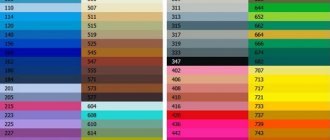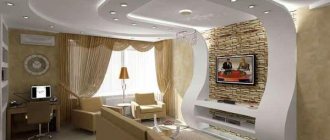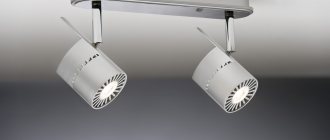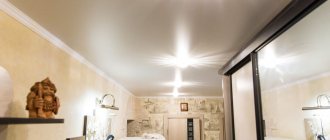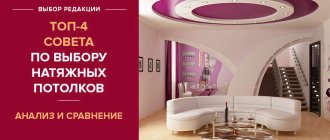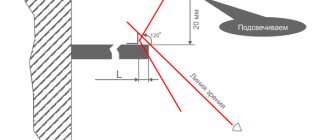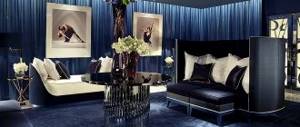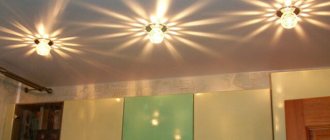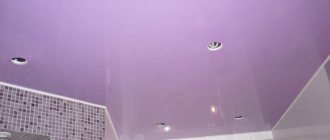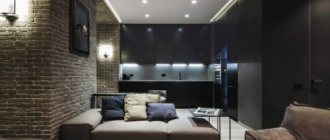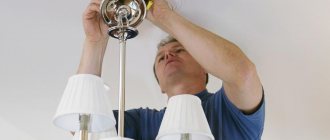The undeniable attractiveness of suspended ceilings is associated with the speed of installation and the ability to carry it out in rooms with finished finishing. Glossy canvases are increasingly giving way to elegant satin and matte finishes, gaining space under the ceiling only in pop art and hi-tech styles. And yet doubts remain: which material to prefer - fabric or PVC? Each solution has advantages and disadvantages, but the advantages of fabric stretch ceilings objectively outweigh their minor disadvantages. Let's take a closer look at why textile fabrics are good, what they are made from, how to avoid fakes and complement the interior with an elegant ceiling.
What is a fabric stretch ceiling and what does it look like?
Fabric panels used for the installation of suspended ceilings are produced by weaving polyester threads followed by polyurethane impregnation to increase moisture-repellent properties. Polyester is a synthetic material that resembles wool in appearance and has similar characteristics to natural cotton.
Due to the specifics of production, the canvases are made only in matte versions, but they can imitate natural suede, chintz fabric, or be made in two layers - when an embossed layer is applied to the mesh base.
These features provide fabric stretch ceilings with a solid and noble appearance.
Flaws
Unfortunately, like any other material, fabric ceilings have their disadvantages:
- Doesn't hold water. Once on the fabric ceiling, water begins to ooze out after a while. This negatively affects the decorative properties of the material.
- The safe period of time for cold water is 24 hours, for hot water - 6. Remember that to eliminate the water formed due to flooding of the room by your neighbors above, you should call specialists.
- If any part of the ceiling is damaged, the material should be completely replaced and a new one installed.
- You will not be able to get a seamless fabric ceiling if the width of your room exceeds 5 meters.
- The high cost of such an accessory as fabric stretch ceilings. The price of the canvas starts from 400 rubles/m2. The price increases depending on the manufacturer and color of the material.
Types of fabric stretch ceilings
The choice of ceiling fabric decors is much more modest than that of budget PVC analogues. And yet there is quite enough scope for the implementation of design ideas.
White canvas
The traditional white color is still in demand when finishing ceilings; in addition, manufacturers take special care to control the uniformity of the shade over the entire surface of the material. From the point of view of economic feasibility, this material is the most attractive, since the price is slightly higher than the cost of a PVC ceiling, and the already installed canvas can be repainted up to four times.
Colored fabrics
Despite the fact that the choice of colors does not exceed two dozen, these ceilings are no less popular. Their cost is higher than that of white canvas, but this is compensated by exceptionally smooth and deep matte shades. The absence of surprises is also important - the consumer is already sure at the project stage what color the ceiling covering will be.
Glitter
This is a solution for those who find matte ceilings boring - in such cases, you can choose textiles with soft shimmer or splashes of glitter. With the right lighting, you can achieve interesting visual effects. However, the cost per square meter of stretch ceiling will differ significantly and upward.
Acoustic ceilings
The use of special woven materials for suspended ceilings allows you to get rid of unpleasant acoustic effects - manufacturers offer fabrics with special substrates that eliminate the occurrence of echoes. Such fabrics are in demand when decorating recording studios and other special-purpose premises.
Translucent fabrics
This type of fabric allows you to create interesting ensembles due to the lamps located above the ceiling level. But there are also “pitfalls” - if the lighting fails during operation, then it will not be possible to dismantle the ceiling and then install it again. Therefore, special attention will need to be paid to the selection of lighting equipment, focusing on the longest manufacturer warranties.
Photo printing
The most expensive option of all types of fabric ceilings, allowing you to add individuality to the interior. The choice of subjects is not limited; photographs provided by the customer are also used. The only condition is high image quality, since the textured surface of the material somewhat blurs the clarity of the picture.
Suede fabric ceilings
There are different types of suspended textile ceilings. Today they produce glossy, matte, varnish, satin and suede metallic stretch ceilings.
Suede ceiling is the basis for arranging the ceiling. This is not an independent texture, but rather an additional element. When something is missing and you think, let’s stick something interesting on it. Suede is great for a starry sky ceiling.
These are special light ceilings, and similar translucent sheets are used for niches where lighting fixtures will be located. The light that penetrates through such a coating will create a special, romantic atmosphere.
Benefits of fabric
The main advantage of fabric canvases is that this is the only modern material that allows for seamless finishing of the ceiling with a minimal reduction in the height of the walls - with the correct geometry of the room, only 15 mm will be required for a suspended ceiling. Moreover, the costs for such finishing will be lower than for plastering and painting work. However, the list of advantages is quite extensive:
- Frost resistance . Fabric ceilings can be considered for unheated rooms; even at -40, the material retains its original elasticity and does not become brittle.
- Resistance to elevated temperatures . Operation is possible at temperatures up to +80 degrees, which allows the use of canvases in attic spaces.
- Seamless . The width of the roll reaches 5.1 meters, which, taking into account the installation allowance, is a full 5 meters of a single surface.
- Antibacterial . Ceiling fabrics are not susceptible to the spread of fungal mold and bacteria.
- Durability . The material is resistant to mechanical stress. It can be damaged by deliberate effort, but it will not be possible to accidentally break through the canvas by catching it with skis or a stepladder.
- Fire safety . All fabrics are impregnated with special compounds, due to which they do not support the spread of fire and cannot cause rapid smoke.
- Hygroscopicity . Fabric sheets briefly retain water, while allowing steam and moisture to pass through, allowing the ceiling beams to “breathe” and do not create a greenhouse effect.
- Versatility . Fabric ceilings are stretched in cases where heating with guns is impossible.
- Aesthetics . In the area where the lamps are attached, yellow spots or unevenness do not appear, like with PVC sheets.
In general, it can be argued that the advantages of fabric stretch ceilings more than compensate for their disadvantages.
Disadvantages of fabric fabric
The main disadvantage is the inability to re-install the fabric. You can’t stretch the ceiling, decide that photo printing would look better, dismantle it to apply the design, and then install it again. If the interior looks unfinished due to the monochrome ceiling, then there are few options: hand painting or new fabric.
Also, the disadvantages include the following nuances:
- a limited number of “native” fillets for decorating classic interiors, difficulties with attaching arbitrary decorative elements;
- the need to avoid fabric joints so as not to use special linings;
- operation in rooms with moderate humidity, otherwise dirty streaks are likely to appear.
It should be noted that fabrics absorb tobacco smoke, so smoking in rooms with such a ceiling is not recommended.
Popular manufacturers and how to recognize a fake
The technology for producing fabrics for suspended ceilings is relatively young, but over the past decade and a half, three manufacturers have earned the trust of consumers:
- Cerruti (Cerutti) - Switzerland.
- Descor (Deskor) - Germany.
- Clipso (Clipso) - France.
The fabrics of all these brands are distinguished by their density, increased moisture resistance, and uniform thread weaving. The collections include translucent, acoustic, snow-white, suede and double fabrics with various patterns. Rolls are available in widths of 310, 350, 410, 450 and 510 cm.
There are very few counterfeit products on the market, since PVC is easier to counterfeit than fabric materials. But if suddenly the price is unexpectedly low, then this is a reason to be wary - standard fabric ceiling solutions cannot cost less than 500 rubles per square meter. It is also worth paying attention to the quality of packaging - world-class manufacturers supply rolls with inserts describing the characteristics of the material and symbols for its use. And the packaging itself is branded - it contains logos and company names.
Installation technology
Since the fabric does not stretch, it does not need to be heated. This allows installation in small spaces to be carried out alone without special skills. However, it should be remembered that there is always a risk of insufficient tension of the material, and it cannot be dismantled for reuse. Therefore, in large and geometrically complex rooms it will not be possible to do without specialists or qualified assistants.
The installation process can be divided into six stages:
- Marking the level and location of lighting fixtures (according to previously completed wiring).
- Adjustment of fixing baguettes to the size of the perimeter of the room.
- Installation of baguettes.
- Fabric stretching.
- Trimming the excess.
- Decoration with ceiling plinth.
If the room is furnished, then the interior items must be covered with film or fabric. With flat ceilings, it is enough to step back 1.5-2 cm from above and mark the level.
It would be a good idea to check the integrity of the wiring to be sure that you won’t have to work with electricians for a long period of time.
Then holes for dowels are drilled around the perimeter of the ceiling at a distance of approximately 10 cm, baguettes are applied and secured with self-tapping screws.
The roll of fabric needs to be unrolled and left for a while to straighten out. After half an hour, you can begin installing the canvas, for convenience, fixing its corners with crocodile clothespins. You can do without them if you have someone to hold the canvas suspended.
Using a rounded spatula, you need to push the fabric into the baguettes, starting from the smaller walls (if the room is rectangular and not square), or from two opposite ones. From the conventional middle of the wall, you should alternately move to the corners of the room, fixing the fabric. This is the most critical stage, requiring careful and unhurried work so that the canvas is tensioned evenly.
After the fabric is fixed, you need to trim its excess with a construction or stationery knife so as not to touch the stretched fabric. Most likely, this will not be done perfectly, so the last step is gluing the decorative fillets.
Important: glue or sealant should be chosen colorless and applied only to the edge that is fixed to the wall.
If possible, it is better to save a piece of fabric to practice how to care for a suspended ceiling.
Features of installation of the canvas
Installing a fabric stretch ceiling does not take much time. The work is carried out in several stages:
- Markings are made on the walls along which the baguette will be fixed. It's easier to use a laser level for this.
- The baguette is attached to the wall with dowel nails.
- The stretch ceiling fabric stretches. Its attachment to the baguette begins on one side of the wall. The first area to be fixed is 15-20 centimeters from the corner.
- Afterwards, the fabric is stretched and fixed on the opposite wall. It is important not to overtighten the canvas so that it does not tear. Do the same with the two remaining walls.
- The remaining excess fabric is cut off with a sharp knife.
If you plan to install a chandelier in the room, then before stretching the fabric ceiling, install a hook or a mortgage in the right place. In addition, the wiring of electrical cables is done beforehand. After the final installation of the structure, changing anything in the electrical wiring will be problematic.
More details about the installation technology are described in the video.
Rules of care
The durability of the fabric covering directly depends on its proper care. If there are many such ceilings in an apartment or house, then it is better to purchase a special vacuum cleaner. You can also use a regular one if a soft-bristle attachment is provided. The “nozzle” of the nozzle should not touch the material during cleaning; any active pressure on the surface must be excluded, as well as exposure to abrasive cleaning agents on the fabric. You need to vacuum the ceiling at least once every two months, especially in children's rooms, since the health of the residents depends on the cleanliness of the air.
Wet cleaning would be more productive, but it can leave streaks after drying, which can only be removed by painting the entire ceiling. Therefore, in cases where it is necessary to remove an obvious stain from the surface, it is advisable to try to repeat the stain on the remainder of the material and then wash it off. The rags should be chosen white or one that is guaranteed not to stain the ceiling. Also, do not make circular movements, as a result of which areas of changing shades may appear. In some cases, it will be more effective to use a soft sponge with a gentle soap solution; aggressive detergents should not be used.
You will need to blot the wet area with a lint-free cloth, or use a hairdryer to dry it, holding it at a distance of at least 20 cm.
Read more: Caring for fabric stretch ceilings
Advantages
Fabric stretch ceilings have many advantages. The pros and cons of this material will help each person decide whether it is worth installing this canvas.
- Suitable sizes. Seamless installation can be carried out in almost any room, because manufacturers offer ideal canvas sizes. It can be installed not only on the ceiling, but also on the walls.
- Strength of the material. It's hard to damage. The fabric ceiling also exhibits resistance to temperature changes. The frost resistance of this fabric allows this material to be installed in rooms where there is often no heating. Therefore, this is an ideal option for country cottages. This type of ceiling does not deform or crack.
- Long service life. Fabric ceilings retain their color for a long time. They are environmentally friendly. During the manufacturing and installation process, components and materials are used that do not harm human health. They can be used in children's rooms. In addition, it should be noted that the fabric ceiling material “breathes”.
- Easy installation. When installing this type of ceiling, you should not heat the room or use additional materials. You just need to make sure that the furniture does not interfere with the installation of the baguette. Fabric ceilings can also be repainted up to 4 times with water-based paint if desired.
- Soundproofing. There are special acoustic fabric ceilings, in which a special substrate creates an echo effect in the room.
- Antistatic. Thanks to the special coating, dust does not accumulate on the surface of the material, so it does not require special care.
- Does not support combustion. This type of ceiling is also installed in rooms with increased fire safety requirements.
- Decorative. This is an ideal surface for creating artistic painting or photo printing.
Myths about fabric stretch ceilings
Marketing techniques have not spared stretch fabric ceilings, which has given rise to several myths about this irreplaceable material.
The myth about the environmental friendliness of polyester material should be dispelled first. In rare cases, you can purchase a fabric ceiling made of natural fiber or fiberglass, but this does not make much sense, since this material will also be impregnated with polymers.
Rather, we can say that there are no unpleasant chemical odors that are inherent in PVC ceilings. A fabric stretch ceiling is installed without heating, so there is no need to ventilate the room for a couple of weeks. However, even in attic rooms, where the roof, and therefore the ceiling, gets very hot during the hot season, there will be no discomfort or foreign odors from the fabric.
The second misconception is based on the statement that a suspended ceiling will protect the decoration of the room from the effects of flooding. Yes, fabric sheets are especially durable and can hold water for up to 48 hours before they begin to let it through. But the fasteners will not hold up faster, since the fabric does not stretch and cannot serve as a “vessel” for water. In addition, contact with water is contraindicated for such ceilings, as unsightly stains are inevitable.
And the last myth talks about the practicality of a fabric ceiling, since it does not become electrified and does not become a breeding ground for fungi and mold. At the same time, it absorbs odors, collects dust and does not tolerate wet cleaning.
Popular brands
Today, there are many manufacturers who offer their consumers stretch ceilings of various types and qualities. The most popular are:
- Clipso.
- Descor.
- "Cerutti".
Clipso fabric stretch ceilings are manufactured by a French company. It produces premium coatings.
Descor fabric stretch ceilings are manufactured by a German company. This material is known throughout the world for its excellent German quality. The Descor company, like the previous one, produces the best fabric stretch ceilings.
is also in demand all over the world.
These manufacturers have proven themselves to be reliable suppliers of quality material. Each of them offers the consumer a high-quality fabric stretch ceiling. The pros and cons of each of them are practically the same.
Where is it recommended to install fabric ceilings?
Some manufacturers recommend installing their products on unheated loggias and verandas. Considering the frost resistance characteristics, this is a good solution. But it is suitable only in cases where heavy condensation does not form on the ceiling beams due to temperature changes, and moisture will not leave streaks.
Due to elevated temperatures, such ceilings should not be installed in saunas and hammams, and due to high humidity, they should not be installed in bathrooms and rooms with a swimming pool.
Also, no matter how efficient the exhaust system is, due to the high absorption of odors, a fabric ceiling is not suitable for the kitchen. But it will decorate the dining room, bring an element of luxury to the hall and living room, and create a comfortable environment in the bedroom and children's room.
The range of fabrics is wide enough to eliminate difficulties in implementing various interior styles. However, you need to remember that ceiling fillets will be required in any case, and when developing style solutions you need to choose not only fabric, but also related materials.

